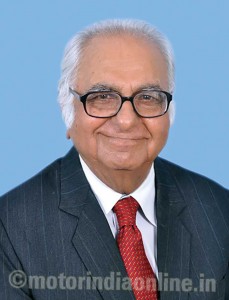By B.S. Khurana
Roads of Ruin
As per NCRB 2013 report, 34 per cent of all unnatural accidental deaths in India took place on our roads, which is 1,37,000 or 373 daily. Already the World Health Organization (WHO) has parked India on the top of the global heap. ADB report 2012 says, 7 out of 10 road crash victim families suffer major income drop, many driven to debt or poverty. 53 per cent killed are in age group of 25-65, another 32.3 per cent belong to 15-24. Estimated GDP loss of 3 per cent could possibly take care of malnutrition.
State role

The States need to invest urgently and heavily in integrated policy planning, build intelligent and forgiving roads that can absorb growing vehicle flows, safe pedestrian crossings and foot bridges, modernized traffic monitoring, efficient traffic police with speed cameras, breath analyzers and comprehensive post-accident assistance and investigation systems. A minor collision is equally important as a serious injury as both are result of “failure to act correctly”. High density traffic is stressful and PSV drivers, in particular, are prone to health problems impairing their control and reaction time. Planners should log for “friendly-environment”.
More mandatory safety aids should be in force, like crash protection and roll-over safety, airbags, anti-lock braking system, electronic stability control [skidding and control loss], rear safety belt, child restraint.
We need urgent intervention and policy for safety of pedestrians, cyclists, school children, PSV driver selection, and training and licensing. An economist will tell you, 70 per cent of future jobs will be in cities, this teaming mass will need at least 30 million homes, development needed for 20 times the roads and subways already constructed.
Citizen role
Alongside, following traffic rules, wearing helmets and safety belts, not using mobile phones, are to keep people safe.
By rejecting these, citizens seriously harm themselves and others. A sense of entitlement pushes some to break regulations like not stopping in red light, wrong overtaking, lane cutting, undermining rules and thereby, causing clearly unavoidable tragedies. Along with focused government action and tough enforcement norms, through training programmes for road safety from school level are urgently required. Well placed intelligent signals and signage are needed across the network.
International studies
Well-aimed road safety policy could prevent many households from falling under poverty line.
Road safety activities are highly cost-effective and provide a higher rate of return than another in transport.
Policy interventions of accidents, crashes, enforcement are best based on investigations, e.g., seat belt use reduces the risk of being killed by 40-50 per cent.
Approximately, 90 per cent of all sensations that influence, come through eyes. Any deficiency is dangerous. Psyco-physical testing is mandatory before grant of license. Visual acuity, color perception, vision field, depth perception [space-distance], glare recovery, colour recognition is a must. Safety information starts at schools.
Most pedestrians in India have no experience of driving. Home to largest population of illiterate adults at 287 million [UNESCO], drift to cities of rural people, poses danger to their lives, unable to perceive action of drivers, they contribute majority of accidents, after vehicle drivers.
India has the most students in the world, nearing 318 million population of USA. Its youth population [15-24] is about 240 million. If we catch them young, coming generations will be a safer and happier lot, start a mass movement today!
Children’s education holds the key, before they take to the wheel.
The last word
Road safety is everyone’s concern. All of us are road users. If we can reach the message that safety is not by chance or accident, we can make people think differently, as these are preventable. Road safety has to be learnt, practiced: think safety, be defensive, aware of road reality. Accident figures and human tragedy index is known. Danger cannot be eliminated by silence and forgetfulness. Increasing traffic density will always impose limits on road safety. Automobiles and roads must continue to be developed to minimize injury and damage and man has to develop his equally subjective behavior to these conditions. Man, machine, road together will provide more safety to the State and the society.